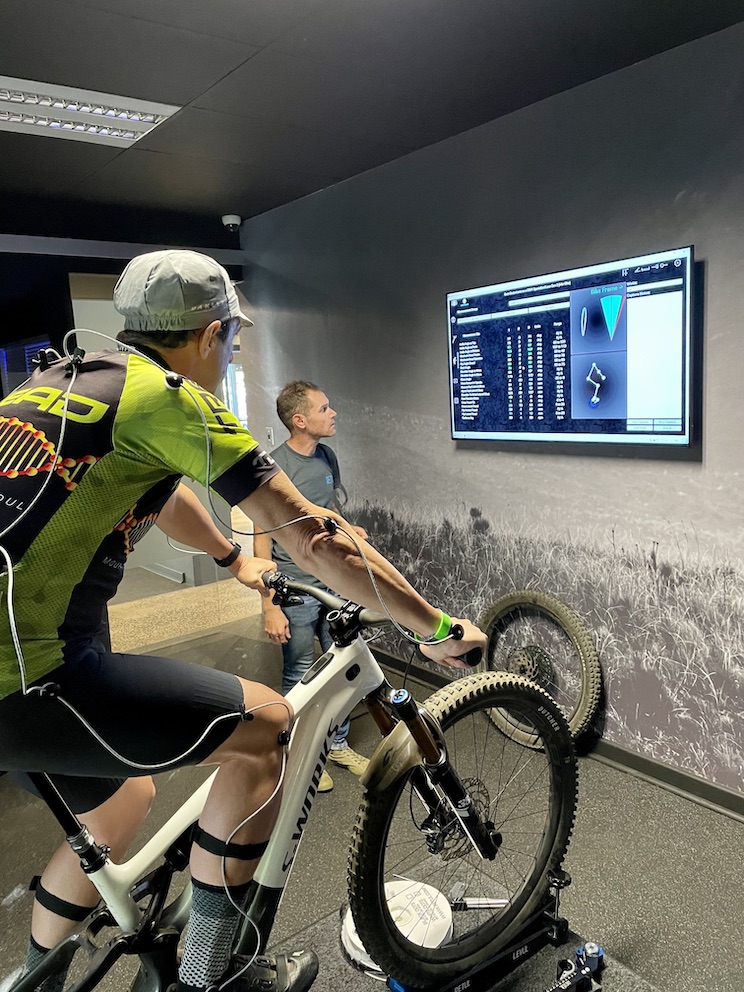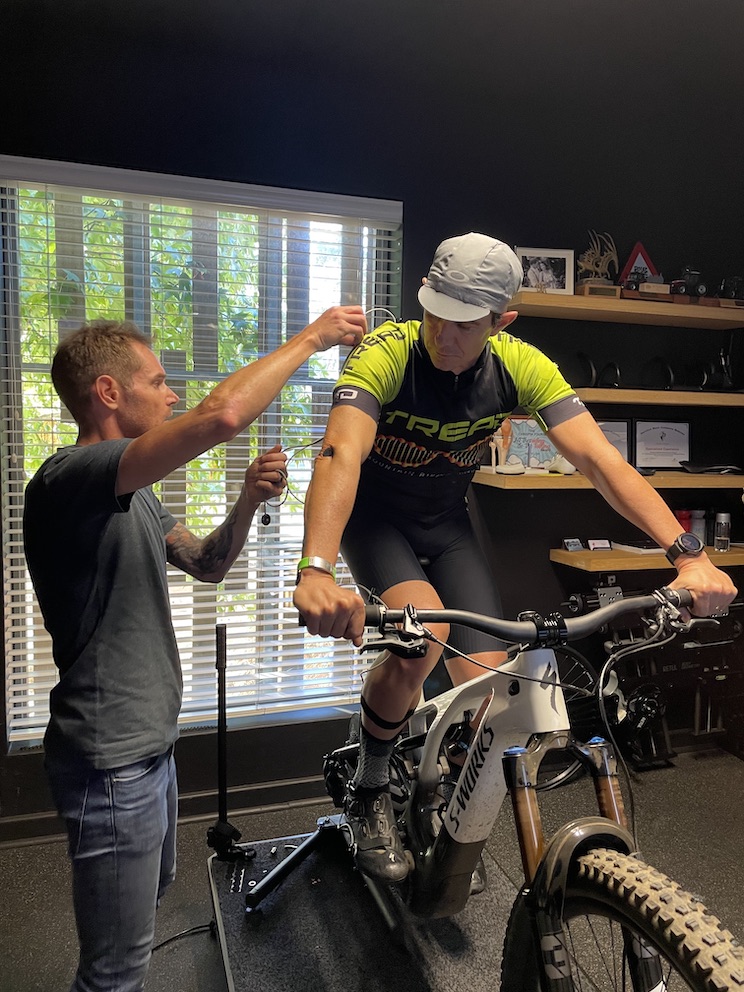Part of my job is to test ride and write about different bikes. In a normal year I ride between 20-30 different bikes; during Covid-19’s reign, it’s been fewer as brands just don’t have much in the way of demo stock. Anyway, the topic here is bike fitment. I certainly don’t have 20-30 different bike fitments done each year. But I had one a few months back and here are five key things I learned.
By Sean Badenhorst
Seventy-three centimetres – that’s the only measurement I use when I get a new bike to test ride. That’s the distance from the centre of the bottom bracket to the top of the saddle that’s always seemed to work well for me in terms of saddle height. Once I have set the saddle height, I then check saddle fore/aft position, handlebar angle, brake levers/gear shifters/dropper post remote position, attach my pedals and start riding.

High tech! This Retul Fit 3D motion capture system is able to measure everything except your mood.
Okay, somewhere in there I also check shock pressure/sag/rebound setting and tyre pressure, but the point is, I don’t get a professional bike fitment every time I ride a different bike. Does it affect my riding performance? Hard to tell really. Why? Because I’m not a committed racer, fixated on performance. Well, I haven’t been one of those for a few years. I also don’t really suffer from serious pain when riding and I feel in a position of control.
I have had a number of different professional bike fitments over the years and have watched this industry segment grow and mature over the past three decades. It’s been fascinating to see how technology has been incorporated into professional bike fitment and how personalised a bike fitment actually is.
Sure, there are some general elements at play, but significant segmentation of bicycles and riding sub-disciplines has made bike fitment probably more important than ever, especially if you’re highly committed, even slightly competitive or just want to be comfortable, pain-free and fully in control.
In March 2021, I got the opportunity to have a Retul Bike Fitment at Specialized Stellenbosch with Waylon Woolcock. I have known Waylon for many years, having reported on his achievements as a pro roadie and mountain biker. During his latter racing years, Waylon was already doing bike fitments, but since he retired, he’s focussed on it full time and is considered one of the top Retul Fit technicians in the world.
I was test-riding the new Specialized Turbo Levo Generation 3 on this trip. I had already done one ride that morning. I was only going to be doing one more ride the following day, so it was more like a fleeting rendezvous with this bike than a short- or medium-term relationship. But the Retul fit was more about me experiencing the process and helping me improve my own riding position.

The Specialized Body Geometry Footbeds (Medium support) and Varus wedge appear to have improved my foot position, sitting position and pedalling stability.
Here are four important things I learned from my Retul Fit.
1. My left leg is 20mm longer than my right leg
This was more a confirmation than news to me. Previous bike fitments had revealed this discrepancy in my leg length. It seems to be as a result of pelvic ‘twist’ rather than actual leg length. As with most middle-aged cyclists, I could (should!) do more core strength training and stretching to improve this. But this obviously affects my pedalling symmetry and seems to cause me to pedal with a (very slightly) ‘skew’ body.
2. I lack symmetry in my pedalling action
This is probably mostly because of my weaknesses as explained in No. 1.
- My left knee moves 29mm laterally while my right knee moves 44mm laterally.
- My hip-to-foot lateral offset on my left hand side is 27mm compared to 18mm on my right hand side
- My left foot rotation mean is -10 degrees compared to -5 degrees on the right
- My left knee is -1mm forward of the foot and my right knee is -13mm forward of the foot.
Those are just the measurements which showed the biggest differences in symmetry, but there are a lot more measures done on the Retul Fit for Saddle Position, Handlebar Position, Pedalling Alignment and Knee Paths. It’s a very thorough process. This is all measured with 3D motion capture technology using sensors which are placed on certain parts of your body (mostly at the joints) to be able to measure and record your pedalling action and body position.
3. My shoes were shot!
I have a few pairs of mountain bike shoes, but the pair I have worn most in the past few years are a pair of Specialized Comps. Although a bit heavy, they’re comfortable, durable and sit really firmly in place. But while they still looked good on top, Waylon showed me that the tread lugs were worn and unstable. The cleats were also too worn to be effective. Needless to say, I have new shoes and cleats now. The pedals I took with me to Stellenbosch were also worn. The axles were giving some play, which can accentuate knee instability.
4. My cleats were in the wrong place
There are two position options in which you can attach your cleats. Mine have been in the forward position for a few years, as advised by a previous bike fit technician using a different system who said I needed to engage my glutes more. Waylon moved them to the rear position beneath the fifth metatarsal saying that this would improve my knee stability and reduce my knee flexion at the top of my pedal stroke.
5. My right foot arch is higher than that of my left foot – by quite a bit
Waylon felt that my high-arched right foot and my medium-arched left foot would both benefit from Specialized’s Body Geometry Footbeds (insoles). In order to bolster my right foot further, Waylon added a Varus wedge, which reduces the angulation of my right forefoot. I only used the standard insoles on all my shoes previously.
Waylon made a few adjustments to the bike too, but they were fairly minor, which confirms the size of the bike (S4) was good for me and the prep done by Specialized Stellenbosch before I collected it was spot on for my weight.

Waylon is one of the leading Retul Fit technicians in the world.
It’s been just over three months since I had the Retul Fit with Waylon. I have ridden a few different bikes in that time, but can definitely feel that my pedalling action is more stable. It’s most noticeable when I spend a couple of hours on the smart trainer because I can really focus on how I’m feeling and pedalling. I was getting a bit of left lower back/upper glute discomfort/mild pain before the fitment, but that’s now gone, which is great, especially on long rides. I’m assuming it’s because I am now better aligned due to the specific footbeds and the wedge in my right shoe.
My experience with bike fitment over the past three decades is that while the technology and changes made to the rider’s position are important, the bike fit technician’s experience and manner are what you really respond to and remember. Waylon has done fitments for hundreds of cyclists, including world champions, but he has a way of making you feel like the most important cyclist in the world during the session and that’s pretty cool!
You can book a bike fit session with Waylon if you’re in Stellenbosch via this website.
Specialized also has Retul Bike Fit technicians at other South African stores. You can find your nearest one here.

